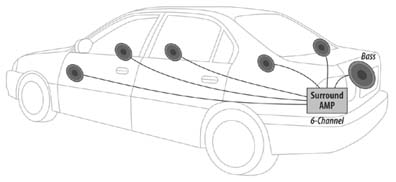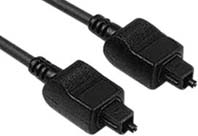Hack39.Put Multi-Channel DVD Surround Sound in Your Car
Hack 39. Put Multi-Channel DVD Surround Sound in Your Car
If you already have four or more speakers in your car, it's a straightforward upgrade to go from stereo to multi-channel sound. Surround sound is a term used to describe a number of different approaches to "surrounding" the listener with sound in a movie theater, home theater, or, in our case, automotive theater. The basic concept of surround sound is to place multiple speakers strategically around the audience, giving them sound from all directions. By sending different types of sounds to each speaker, a 3D effect is created, where things can be heard coming from behind, passing by, and going off into the distance. Even dialog can be positioned in space around the listener. The unique sound sent to each individual speaker is called a channel, and the number of channels in the sound determines how many speakers you need to reproduce it. Each channel of sound in these systems has a specific function and helps to produce the overall 3D sound experience. Surround sound systems usually have an array of speakers in front of and behind the listener, as well as a low-frequency channel for special effects such as explosions and rumbling. The designation 5.1 describes a system with five normal audio channels and one low-frequency effects channel. If you add a rear center speaker, you get six audio channels plus a bass track, and this is called 6.1. If you go to four rear speakersleft surround, right surround, left rear, and right rearyou have 7.1 sound. Figure 3-21 shows the normal elements of a surround sound system. Figure 3-21. Different types of surround sound Although your car might have eight speakers, it really has only two basic channels (stereo). The bass amplifier usually uses a crossover to extract the low frequency from these two channels and sends that to the bass speaker. In cheaper subwoofers, the crossover, amplifier, and bass speaker are in a single self-contained unit. The other four to eight speakers (front and rear, midrange and tweeter) play back either the left or the right stereo signal. Your car probably has balance and fade controls, but these simply adjust the relative volume between left and right or between front and back. You're still listening to the same two channels of sound; they're just being sent to you from all directions. In the specification for surround sound systems, each speaker is supposed to work at a certain frequency range (like the tweeters, midrange, and bass speakers in a car) and be positioned at a precise distance from the listener. In the car, though, you generally won't want to move the speakers you already have. Instead, you simply want to change their purpose, and add a couple of additional speakers to fill out the missing roles. Figure 3-22 demonstrates that for each distinct channel in a car, you may actually have two speakersa midrange and a tweeter. The different channels in surround sound really describe where the sound is supposed to come from (rear right, behind, center front, etc.). Most cars have stereos that output four signals, which are then split into eight speakers. To install true surround sound, you'll use these eight speakers (four pairs) as the front channel and rear surround speakers, and then add a center channel and a subwoofer. Figure 3-22. Surround sound in a car 3.18.1. DTS Versus Dolby 5.1There are several competing surround sound systems. DVDs usually come with tracks in both the DTS and Dolby 5.1 formats, as well as in stereo. Surround sound processors are designed to take the sound from a DVD player and split it into the six or more surround sound channels. In a home theater setup, you usually have a separate amplifier unit that performs this function, connected to the DVD player via a single digital link. For an in-car computer, you can use DVD player software such as Power-DVD (http://www.gocyberlink.com) or WinDVD (http://www.windvd.com)to decode all the surround sound formats without requiring any additional hardware. 3.18.2. Audio ConnectorsNaturally, if you're decoding six channels of sound, you need six physical audio outputs, and thus you need a sound card that supports this. There are two basic approaches to implementing six-channel sound. 3.18.2.1 Analog approach.The analog approach is to get a sound card with six outputs (three stereo pairs). Then, you can use two or three car audio amplifiers [Hack #15] (depending on whether they are two-or four-channel) to amplify these six audio signals. The VIA EPIA boards, for instance, have a mode where the three audio connectorsnormally line-in, line-out, and microphonebecome six-channel sound. By connecting a 3.5 mm to RCA out pair to each of these, you get the six audio outputs you need for the surround sound. You can also get USB 5.1 sound output devices that have the necessary six outputs. 3.18.2.2 Digital approach.The digital approach to surround sound decoding allows the signal to travel digitally from the computer to the amplifier or sound decoder. In this arrangement, the digital to analog conversion occurs nearer to the amplifier, reducing analog losses. S/PDIF (which stands for Sony/Phillips digital interface) is a protocol and physical standard for sending multiple channels of sound digitally over a wire. Actual implementations of S/PDIF can travel over coaxial wires or optical cables. Many sound cards have both S/PDIF inputs and outputs for compatibility with any audio equipment you might have. The coaxial S/PDIF interface uses the common RCA connector. Optical S/PDIF comes in two physical connector formats. Toslink (Toshiba link) is an optical connector format (shown in Figure 3-23) that can carry S/PDIF and other optical audio transmission protocols. A Toslink cable consists of a single, flexible, insulated optical cable, with squarish connectors on both ends that click into the female receptacles of Toslink devices. There is also a smaller version of this connector format, called mini-Toslink (found on devices such as MiniDisks), that can be converted to Toslink with a simple adapter. Figure 3-23. Toslink connectors By using digital cabling as much as possible, you increase audio quality and reduce the number of wires, because one digital cable can carry all of the audio channels. Surround sound is becoming popular in cars, and the aftermarket has started to realize this. You can already get an all-in-one 5.1 sound card and amplifier combo for your computer from Creative Labs, and companies are starting to manufacture the same type of product for the car. For instance, the company Phoenix Gold (http://www.phoenixgold.com) makes a six-channel (5.1 sound) amplifier, called the OCTANE-R 5.1MT, that has optical Toslink inputs and coaxial inputs, and powers five car speakers at 100W and a subwoofer at 200W. It even has onscreen computer controls, which are a really nice feature. If space is at a premium, or if you don't want to fill your trunk with amplifiers because you want to leave room for computers, this is a great solution. 3.18.3. Auto UpgradesPart of the beauty of using a computer in your car is that you get to upgrade to the latest technologies without getting a new car, and sometimes without even getting new hardware. If DVD software evolves to support an enhanced DVD feature, you can simply install the new program in your car, and you're up to date. If you want to upgrade to some new audio or video technology in your car, even HD DVD, you can bet that your computer will allow you to shortcut the delays of consumer electronics and get the feature before most people know that it even exists. |